I know there are similar questions already floating around the magical interweb, but I have quite a specific issue.
I built a new PC just yesterday, but decided not to go for an optical drive since I haven't used the one on my laptop in years. I figured the best way to install Windows then would be to boot Ubuntu from a flash drive, download Windows from there, and then install it onto the SSD. However, I encountered problems with the storage space on the flash drive(s) I was using, and accidentally ended up installing Ubuntu onto the SSD.
Now I have a bootable Windows OS on my flash drive, but cannot install it as the SSD is not formatted correctly. I assume I'm going to need to boot Ubuntu again, partition the SSD, and then install Windows from there? How do I do this? I'm tearing my hair out...

